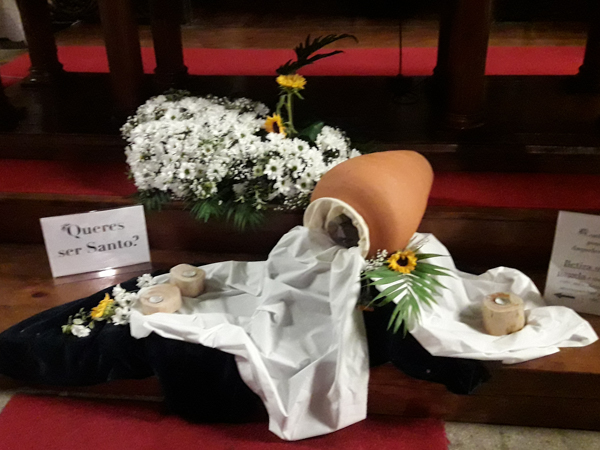From the trip materials:
We will join a local expert at the hotel meeting room for a lecture on contemporary Portugal. Later, we will head by motor coach to historic Guimarães to learn about the town's evolution from medieval settlement to modern city. Its rich building typology exemplifies the development of Portuguese architecture from the 15th to the 19th century through the consistent use of traditional building materials and techniques. Lunch is at the historic Pousada Santa Marinha da Costa, a former monastery and UNESCO heritage site.
Helena Duarte-Baltazar returned for a lecture on modern Portugal:
- The First Republic was chaotic and ended with a military coup in 1926.
- Antonio de Oliveira Salazar became finance minister in 1928. He later became prime minister and one of the longest ruling European dictators (42 years). His regime became known as the Estado Novo. His rule was characterized by social rigidity, censorship, and imprisonment of dissidents.
- In 1961 the Portuguese colonies in Africa began to seek independence. The colonial wars lasted until 1974 when the government was overthrown by another military coup called the Carnation Revolution. It wasn't until 1999 that Macau, the last overseas territory, was relinquished to China. (I visited Macau briefly in 1970.)
- Portugal joined the European Economic Community (predecessor of the EU) in 1986 and became a member of the Eurozone in 2002. It has struggled economically, but is firmly committed to the EU.

Our visit to Guimarães started at the castle overlooking the city. This is the traditional birthplace of the first king of Portugal, Afonso I who led a rebellion against his cousin Alfonso VII, King of Leon & Castile, the true overlord of the region.

We met our first cork oak on the grounds of the castle. This young tree won't be harvested for many years. When the outer bark is removed, the inner bark is bright red. We will see recently harvested trees on the last day of our visit.
Stripping the bark doesn't harm the tree.

Traditionally Afonso was baptized in this chapel on the castle grounds.
We didn't have time to visit the castle or chapel.

The monument to Afonso stands in front of the palace of the Dukes of Braganza.

Next to this door is an early fire alarm.
The box lists churches in the city center with numbers beside their names. In the event of a fire, the cathedral bell tolled the number corresponding to the church so that the fire department would know the quarter of the city that was endangered.

Guimarães is located on the Portuguese pilgrimage route to the shrine of Santiago de Compostela in nearby Galicia. The scallop in the pavement marks the route.

In 1834 at the end of the Portuguese civil war, the government dissolved the monasteries. Monks had one year to find other situations. Nuns received better treatment and were allowed to live out their lives in the convent. According to our guide some convents quietly recruited new residents so that many remained open for some time.
This is the former convent of the Franciscan Order of Santa Clara. It remained active until 1891 when the last nun died. It is now the town hall.

As we reached the heart of the medieval city we crossed the Plaza Santiago. Many of the surrounding buildings dated to the 16th century or earlier. I'm sure the cafes thrive on days that aren't chilly and rainy.
The ancient town hall is around the corner to the left. We walked through the colonnade to the Square of the Olives. Until the early 19th century it was graced by an ancient olive tree.

One side of the square is formed by the Igreja de Nossa Senhora da Oliveira.
There were many shops in the surrounding streets and our group fanned out to explore. We limited our contribution to a postcard.

The church, which still serves as a parish church, had many beautiful things inside, but my favorite was this display in front of the altar. I prefer to view churches as homes of congregations rather than art museums.

Lest we think that the Communist movement is limited to China and Vietnam, the Portuguese Communist Party is alive and kicking. It is much more prevalent in the south of Portugal, but we happened upon the local HQ while searching for postcard stamps.

They are not medieval, but I loved these doors.

We were headed up to the top of the surrounding hills for lunch and to see the view. HA! With luck we would be able to see what we were eating!
The church is Our Lady of Consolation. It isn't old, but it is charming.

Our lunch was scheduled at Pousada Santa Marinha da Costa. We did not have to walk up all the steps, but I skipped the dessert in order to prowl around the place.
The food was, as usual, delicious and the ambiance was spectacular.

Years ago we traveled across the South Atlantic, largely because Jim wanted to visit Tristan da Cunha -- the most remote populated place on the planet. It is named after a Portuguese explorer.
These modern graves are for members of the da Cunha family. Do you suppose Tristan came from here? He is himself buried much farther south.
After our expedition we returned to Porto to board our ship, the MS Miguel Torga named after one of Portugal's great 20th century writers. It was great to unpack. Little things mean a lot. The rest of our stay would be on this comfortable ship.
Click your "back" button to return to the previous page or click for our picture album.